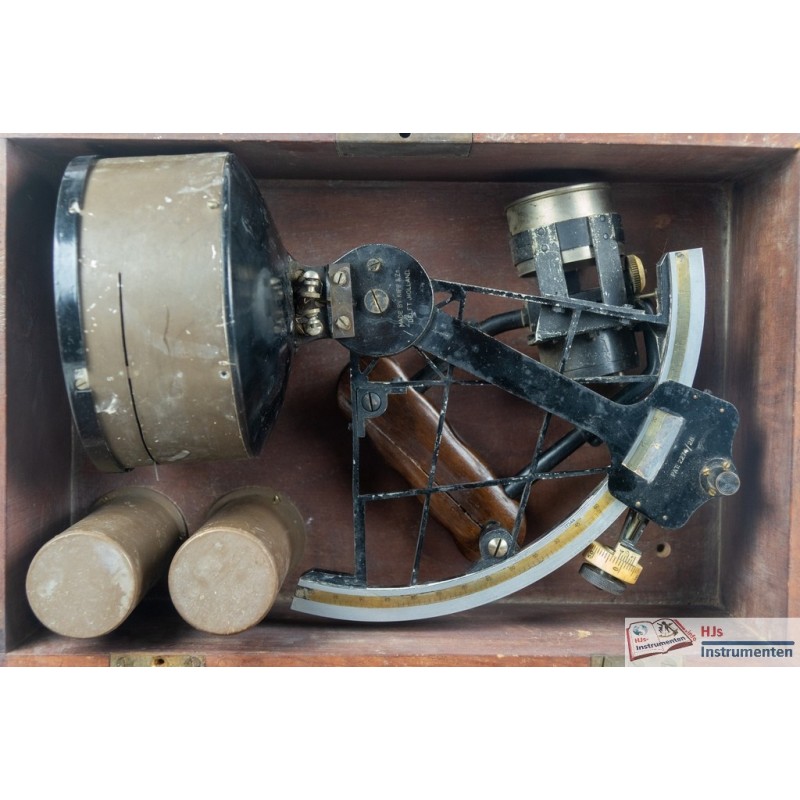





















Kipp & Zn 'MacNeil Allweather sextant'
Obtained from the USA
This is probably both the rarest sextant in my collection, the strangest as well as the most expensive in man hours. This is no ordinary sextant in that it uses optics; rather than observing using mirrors and a telescope this instrument is a radio sextant. The sextant uses a parabolic mirror to actually catch solar radiation ('IR') and focus it onto a receiver creating a tiny current. This current is then amplified (using an external receiver that is no longer with the instrument) with the amp meter shown next to an artifical horizon. The idea was that you could use this instrument to take a suns height in any weather as the radiation would always be present.
It was the artificial horizon which made this instrument the most expensive instrument in my collection. Not that it cost that much to buy, but the seller neglected to inform me that the artificial horizon uses mercury ánd that there was a spare bulb in the box. All of that would not have mattered, hadn't FedEx not been very rough with the parcel ánd if the seller would have properly packaged the instrument. As it was, the instrument and case arrived in shambles with a silvery metal liquid dropping out of the box onto the carpet, floor and sofa. It took me about 10 seconds to realize what was going on and less than a minute before I had most of it outside. Then we called the fire brigade who came up for an inspection and told us we could clean up what was left (a myriad of small globulets all over the floor) by ourselves. Which then took us 2 full days after which we aired the room for another two weeks, living upstairs... So just in man hours cleaning everything...Apart from the lost carpet and sofa cushions...
Anyway, after having put the instrument in quaraintaine to have any remaining mercury vapourize I started restoring the instrument as much as possible. With stuff broken off not an easy task. So unfortunately it cannot be shown in its full glory. The good news is only the spare horizon broke and the original is still in the instrument (which I now treat as a baby, being aware of how much mercury is in there and how much time it will cost to remove it).
Back to the instrument, it works by focussing what was called IR radiation on the detector. Probably more exact, it was not the IR radiation but rather the radio waves generated by the IR / heat from the sun that was picked up by the device. This generated a very small current after having been focussed on the parabolic dish. That current was then fed through a suitcase sized amplifier and displayed on an amp meter. The amplifier is not there but the original blueprint diagram still is. I even managed to find an add showing this type of instrument. An article in Radio Craft describes it in full. I cannot imagine it ever having become really usable. On board a ship the large electronics would not only have been impractical, it is also dangerous in wet weather. But even if that would have worked, the mercury artifical horizon isn't easy to read on a rolling and pitching ship. The other option would be in aircraft use. However, being more stable and definitely not hampered by rain, it would still be very hard to readduring moving. And when you have the reading under control you are dealing with a very small current coming from a very small mirror. It cannot have been very accurate. Later articles from the 1960s show a much larger atttempt at creating a similar instrument which by then was superfluous as electronic positioning systems had become much more reliable.
The original makers of my instrument (Kipp & Zonen from Delft) still exist and are still specialized in measuring solar radation. Could this instrument have started it all? The company is now part of Ott Hydrometrics and their original archives have been turned over to the Boerhaave museum in Leiden together with old instruments. However, no example of this sextant is in the extensive collection of Boerhaave.
The sextant in itself is unmarked other than a (high) serial number and a patent code. The high serial indicates that the frame was sourced from another manufacturer. The patent code (2274/28) is also found on (other) sextants made by Henry Hughes. This corresponds with an earlier sell at Christie's which was actually inscribed with Hughes and Son. This example does not have any inscriptions, so for now that is all I can go on.
Data sheet